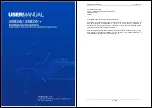
Correctly Wiring Electrically Isolated CAN Networks
9. Correctly Wiring Electrically Isolated CAN Networks
NOTICE
This chapter applies to CAN networks with bit rates up to 1 Mbit/s.
If you work with higher bit rates, as for example used for CAN FD, the information given
in this chapter must be examined for applicability in each individual case.
For further information refer to the CiA® CAN FD guidelines and recommendations
(
).
For the CAN wiring all applicable rules and regulations (EU, DIN), e.g. regarding electromagnetic
compatibility, security distances, cable cross-section or material, have to be observed.
9.1 Standards concerning CAN Wiring
The flexibility in CAN network design is one of the key strengths of the various extensions and
additional standards like e.g. CANopen, ARINC825, DeviceNet and NMEA2000 that have been
built on the original ISO 11898-2 CAN standard. In using this flexibility comes the responsibility of
good network design and balancing these tradeoffs.
Many CAN organizations and standards have scaled the use of CAN for applications outside the
original ISO 11898. They have made system level tradeoffs for data rate, cable length, and
parasitic loading of the bus.
However for CAN network design margin must be given for signal loss across the complete system
and cabling, parasitic loadings, network imbalances, ground offsets against earth potential and
signal integrity.
Therefore the practical maximum number of nodes, bus length and stub
length are typically much lower.
esd has concentrated her recommendations concerning CAN wiring on the specifications of the
ISO 11898-2. Thus this wiring hints forgoes to describe the special features of the derived
standards CANopen, ARINC825, DeviceNet and NMEA2000.
The consistent compliance to ISO 11898-2 offers significant advantages:
●
Durable operation due to well proven design specifications
●
Minimizing potential failures due to sufficient margin to physical limits
●
Trouble-free maintenance during future network modifications or during fault diagnostics
due to lack of exceptions
Of course reliable networks can be designed according the specifications of CANopen, ARINC825,
DeviceNet and NMEA2000,
however it must be observed that it is strictly not recommended
to mix the wiring guidelines of the various specifications!
Page 78 of 105
Manual • Doc. No.: C.2921.21 / Rev. 1.6
CANopen-PN
















































